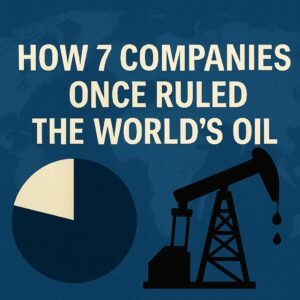Oil companies control more than just fuel prices at your local gas station. They’ve shaped wars, toppled governments, and built economic empires that still influence global politics today.
At the heart of this power lies a group of Western oil giants once known as “The Seven Sisters.” These companies dominated global oil markets for decades, creating a system that continues to affect energy geopolitics worldwide.
This is the story of how seven oil companies carved up the world and why their legacy still matters in today’s energy markets.
The Birth of Big Oil: From Pennsylvania to Global Empire
John D. Rockefeller Creates the First Oil Empire
The modern oil industry began in 1859 when Edwin Drake drilled the first successful oil well in Pennsylvania. But the real power player was John D. Rockefeller.
In 1870, Rockefeller founded Standard Oil. Within two decades, his company controlled 90% of U.S. oil refining and transportation. Standard Oil became the definition of a monopoly.
The U.S. government broke up Standard Oil in 1911 under antitrust laws. However, this breakup actually created more powerful companies. The major pieces of Standard Oil became:
- Standard Oil of New Jersey (later Exxon)
- Standard Oil of New York (later Mobil)
- Standard Oil of California (later Chevron)
Oil Becomes a Global Strategic Resource
As oil’s importance grew beyond America’s borders, European powers took notice. The British and Dutch empires expanded their oil operations eastward.
In 1908, oil was discovered in Persia (modern-day Iran). This led to the creation of the Anglo-Persian Oil Company, which later became BP. Meanwhile, Royal Dutch Shell emerged from a merger between Dutch and British oil interests.
World Wars I and II proved oil’s strategic value. Tanks, planes, and ships all needed oil to function. Countries that controlled oil could control the outcome of wars.
How the Pieces Came Together
By the 1950s, the global oil landscape had crystallized around a small group of Western companies. These included:
- The three major pieces of the old Standard Oil empire (Exxon, Mobil, and Chevron)
- European giants BP and Shell that had built overseas empires
- American companies Gulf Oil and Texaco that had grown independently
Together, these seven companies would form what became known as the most powerful cartel in history.
Meet the Seven Sisters: The Oil Cartel That Ruled the World
Who Were the Seven Sisters Oil Companies?
Italian oil executive Enrico Mattei coined the term “Seven Sisters” in the 1950s. He used this name to criticize the Western oil companies that had come to dominate global markets through decades of expansion and consolidation.
The Seven Sisters were:
- Anglo-Iranian Oil Company (now BP)
- Royal Dutch Shell (still Shell)
- Standard Oil of New Jersey (now part of ExxonMobil)
- Standard Oil of New York (now part of ExxonMobil)
- Standard Oil of California (now Chevron)
- Gulf Oil (merged into Chevron)
- Texaco (merged into Chevron)
By the mid-20th century, these seven companies controlled 85% of global oil reserves outside the Soviet Union and United States.
How the Seven Sisters Controlled Global Oil Markets
The Seven Sisters maintained their dominance through four key strategies:
Exclusive Access: They secured long-term concessions in oil-rich countries, especially in the Middle East. These agreements gave them exclusive rights to extract oil for decades.
Price Control: The companies set global oil prices through private negotiations. Oil-producing countries had little say in pricing their own resources.
Vertical Integration: Each company owned the entire oil supply chain. They controlled oil fields, refineries, tanker ships, and gas stations.
Political Influence: The Seven Sisters maintained close relationships with Western governments. This gave them military and diplomatic protection for their overseas operations.
The Fight Back: How Oil-Producing Countries Challenged the Sisters
Nationalism Rises in Oil-Rich Nations
By the 1950s, leaders in oil-producing countries grew frustrated with the Seven Sisters’ dominance. Their nations possessed the oil, but Western companies collected most of the profits from these valuable resources.
This resentment led to increasing tensions and attempts by various countries to reclaim control:
Iran (1951): Prime Minister Mohammad Mossadegh nationalized the Anglo-Iranian Oil Company. The CIA backed a coup in 1953 that removed Mossadegh and restored Western control.
Other Challenges: Leaders like Egypt’s Nasser, Iraq’s various rulers, and Libya’s Qaddafi all sought to reduce Western oil companies’ control over their resources.
OPEC: The Organization That Changed Everything
These individual challenges to the Seven Sisters were largely unsuccessful. However, oil-producing countries realized they would be stronger working together rather than fighting alone.
In 1960, five oil-rich nations united to form the Organization of Petroleum Exporting Countries (OPEC):
- Saudi Arabia
- Iran
- Iraq
- Venezuela
- Kuwait
OPEC’s goal was simple: take back control of oil pricing and production from the Seven Sisters.
The organization’s power became clear during the 1973 oil embargo. OPEC members stopped oil shipments to countries supporting Israel in the Yom Kippur War. Oil prices quadrupled almost overnight.
This event marked the end of cheap, Western-controlled oil.

The Decline and Evolution of the Seven Sisters
How the Oil Shocks Changed Everything
The success of OPEC’s 1973 oil embargo sent shockwaves through the Seven Sisters. For the first time in decades, they weren’t setting the rules of the global oil game.
The 1970s brought additional challenges beyond OPEC’s pricing power. More countries nationalized their oil resources, and political risks in overseas operations increased dramatically.
Faced with this new reality, the Seven Sisters had to adapt or risk becoming irrelevant:
Many chose to merge:
- Exxon and Mobil combined to form ExxonMobil
- Chevron absorbed both Gulf Oil and Texaco
- BP and Shell remained independent but expanded globally
The New Oil Powers: National Oil Companies
As the Seven Sisters lost control, a new type of oil company emerged to fill the power vacuum. These National Oil Companies (NOCs) were owned by governments rather than private shareholders.
This shift represented a fundamental change in how oil wealth was distributed. Instead of profits flowing to Western shareholders, oil revenues now stayed within producing countries.
Today, these government-owned companies control approximately 90% of global oil reserves:
Major NOCs include:
- Saudi Aramco (Saudi Arabia)
- Gazprom (Russia)
- National Iranian Oil Company (Iran)
- Petrobras (Brazil)
- China National Petroleum Corporation (China)
The former Seven Sisters—now known as “supermajors”—remain large companies, but they no longer set global rules.

Big Oil Today: Facing Climate Change and Energy Transition
Current Challenges for Oil Companies
The descendants of the Seven Sisters now face challenges that would have been unimaginable during their era of dominance. While they’ve survived the loss of pricing power and resource control, they now confront an existential threat: the world’s growing commitment to reduce fossil fuel consumption.
Modern oil companies face unprecedented pressure from multiple directions:
Climate Regulation: Governments worldwide are implementing carbon taxes and emissions limits.
ESG Investing: Environmental, Social, and Governance concerns are driving investment decisions.
Public Opinion: Growing awareness of climate change has reduced public support for fossil fuel companies.
Energy Transition: Renewable energy costs are falling, making alternatives more competitive.
Different Strategies for Survival
Oil companies are responding differently to these challenges:
Diversification: Some companies like BP and Shell are investing heavily in renewable energy, hydrogen, and carbon capture technologies.
Doubling Down: Others, like ExxonMobil, continue focusing primarily on oil and gas production.
Adaptation: Many companies are improving efficiency and reducing their carbon footprint while maintaining oil operations.
The Lasting Legacy of the Seven Sisters
How the Sisters Still Influence Today’s World
Although the Seven Sisters no longer control global oil markets, their influence continues:
Geopolitical Structures: The Middle East’s borders and political systems were shaped by oil company interests.
Economic Institutions: Many international financial and trading systems originated from oil company needs.
Corporate Power: The Sisters pioneered multinational corporation strategies that companies across industries still use.
Energy Infrastructure: Much of today’s global energy infrastructure was built by or for these companies.
Lessons for the Energy Transition
Understanding the Seven Sisters’ history offers important insights for today’s energy transition:
Government Policy Matters: National policies can reshape entire industries, as OPEC demonstrated.
Corporate Adaptation: Companies that fail to adapt to changing circumstances may not survive.
Resource Control: Whoever controls energy resources holds significant geopolitical power.
International Cooperation: Global challenges require coordinated international responses.
Conclusion: From Oil Empire to Energy Future
The Seven Sisters oil companies created the modern global energy system. They built vast empires, influenced international politics, and shaped the world economy.
Today, as the world grapples with climate change and energy transition, the Sisters’ legacy reminds us how powerful energy companies can be. Their story shows both the opportunities and dangers of concentrated corporate power in essential industries.
Understanding this history helps us navigate current energy challenges. Whether future energy companies will use their power responsibly—or repeat the Sisters’ mistakes—remains to be seen.
The age of the Seven Sisters is over, but the lessons from their rise and fall continue to shape our energy future.





